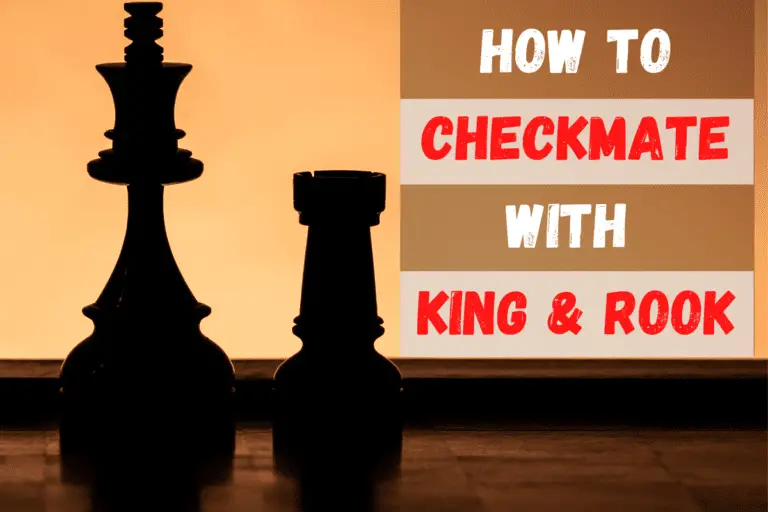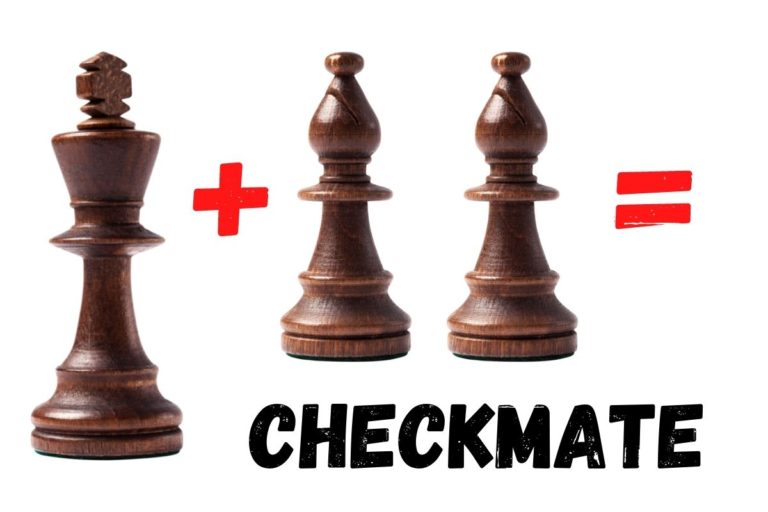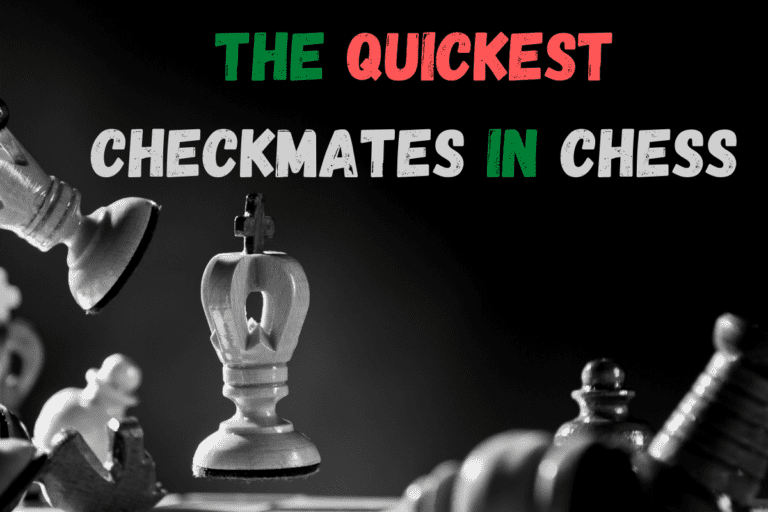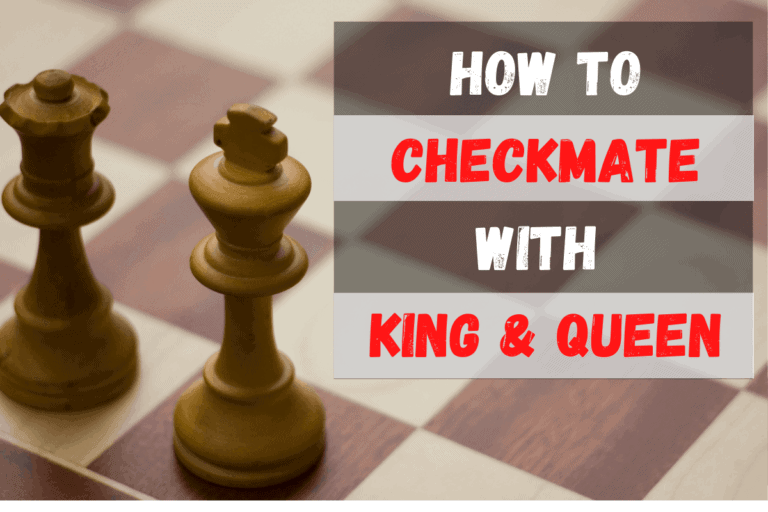Fool’s Mate in Chess (What is it? – How to Win & How to Avoid)
⭐⭐⭐ Take 7 minutes to read and improve your chess game ➡️ : This article was first published on, and is Copyright of Chessquestions.com
Fool’s mate is likely to happen to you in a chess game before you are able to do it to an opponent. As a beginner and not knowing what it is, you are susceptible to the quickest checkmates in chess. And it hurts! Chances are you’ve recently lost a game to Fool’s mate and are now looking for more information, so here goes.
Fool’s mate is the quickest possible checkmate in chess, taking just 2 moves to end the game in a loss for the white pieces. Fool’s mate is only achievable by the black pieces after white moves pawns on the G and F files in a specific way opening the King to a fatal attack from the Black Queen on the h4 square.
This article will demonstrate the four moves, step by step from the starting position and arm you as the white player to avoid fool’s mate and to let you know what to look out for if playing with black pieces so that you might be fortunate to win a game of chess with a 2-move checkmate in the future. I’ll also show you how to win in three moves as the white pieces too.
This article and website uses chess notation, it is easy to understand in less than 15 minutes, and will improve your understanding of chess and also your overall ability.
Fool’s Mate for White
The two moves made by white that allows Fool’s mate are
- g5 – The pawn on the g file moving two squares forward
- f4 – The pawn on the f file moving one square forward
The diagram below demonstrates the 4 moves in total, 2 for white and 2 for black that conclude with a checkmate position.
If g5 and f4 are the first two moves white makes, as long as Black has moved the pawn in front of their King at least one square, it is mate in 1 for black as they can execute fool’s mate on the white pieces.
Fool’s mate for white is not a pleasant experience but something many new chess players playing first may have to go through at least once in their journey of learning this beautiful game.
The fact is, most people know nothing of the Fool’s checkmate until it happens to them, at which point they have to go find out what it is that happened, why it happened, and how to stop a two-move checkmate from happening again. It’s not fun losing a game of chess in just two moves and something you want to avoid happening a second time at all costs.
Only white pieces can fall to the fool’s mate in chess as it is two mistaken moves by the white pieces that allow black to make the same number of moves and checkmate the white King.
How to Counter Fool’s Mate
The way to counter Fool’s mate is to not put yourself in a position whereby a clear route to your undefended and trapped king is achievable by the black queen on the h4 square. Be careful with pawns on the f and g files when playing white.
G5 of F4 Opening for white isn’t always wrong
There is absolutely nothing wrong with making the two moves as described above for the white pawn. Opening with either g5 or f4 is not a problem, but playing as white you should be aware of black playing either e3 or e4 and moving his King’s pawn out of the way of the diagonal route of the Queen to h4.
The reason fool’s mate becomes possible is because white has no defense of anything between the black Queen on h4 and the King.
The White King has no way of getting off the diagonal to h4, and with the pawns ahead of the 2nd row, there is no other piece for white available to block the check.
It is checkmate, the game is four moves old and white has just lost and probably looks a bit shocked right now
Fool’s Mate for Black Pieces
Playing black pieces in chess puts you at a distinct disadvantage even before a piece has been moved on the board. it is only slight but it is real, and most chess games are won by the white pieces given the advantage of the first move.
However, all of that advantage can be discarded if white plays the two moves that allow black to achieve a Fool’s mate in two moves.
Playing as the black pieces, you should always look out for white playing either g or f pawns.
If the g file pawn is pushed two squares forward on its first move to G4, fool’s mate immediately becomes a possibly
How to Win by Fool’s Mate and What to Look For
This is a pretty short step-by-step guide to winning by Fool’s mate as the black pieces, what to look for, and what to do
1. Be prepared for white to play either the g pawn or f pawn on the first move.
As soon as white makes either of these moves, fool’s mate becomes potentially possible, your next move is vital
2. If either f4, f5 or g5 is played by white, move your King’s pawn at least one square forward
By moving the pawn in front of your black King, you immediately open up the diagonal for your Queen to move if white makes the fatal mistaken pawn move
3. If white now moves one of the pawns on the g file or f file fool’s mate is open.
There is now a route from the h4 square to e1 which is where the white King is sitting, it is mate in 1, and you need only make your second move to end the game.
4. Move your Queen to the h4 square, and the game is over and you have won by way of Fool’s mate
Fools mate in chess is not named after anyone in particular, but rather the player of the white pieces who is deemed, (in quite a derogatory manner) to have been a ‘fool’ to have allowed the situation to occur.
Can White Win by Fool’s Mate?
It is not possible for white to win in 4 moves and therefore Fool’s mate is the reserve of the black pieces only, but that is not to say White can not win a game quickly and in the same manner. It’ll just take one extra move thanks to white going first in chess.
As long as black can make the fatal mistake of moving 2 particular pawns in their first 2 moves.
The fastest checkmate for White is three moves
Fool’s mate for white takes three moves and is the fastest achievable checkmate for the white pieces relying on Black to move two pawns on the G and F files leaving a clear path to the black King from the h5 square as long as the pawn in front of the white King has been moved.
The diagram below shows how this is done, and after, there is a step by step explanation of what to look for as the white player.
Step by Step Guide for Fastest Checkmate by White
your opening move should be e4 or d4
These two moves are often considered the very best opening move for white pieces anyway, so there will be nothing strange about playing, what is key is observing what move black opens with
Look out for Black making a f6 or g5 pawn move opening.
If either of these moves is made, you are just a couple of moves away from winning
Do not attack the f or g file with any of your pieces
By doing so you may prevent black from making the second mistake you require to finish the game, so play any move that allows your Queen to get to the h5 square, or if that is already open because you already played e4, move another piece on the Queen’s side of the board and wait…
- If black now moves a second pawn on either the g or f files, move your White Queen to h5
You are now won the game in just three moves, as white is unable to block the Queen’s route to the King and the King is unable to move out of the way.
Is Scholar’s Mate the Same as Fool’s Mate?
It is often the case that someone thinks that Scholars mate is the quickest checkmate in chess and just another name for Fool’s mate, but they are two different things entirely, with Scholar’s mate revolving around the weak pawns on the f2 and f7 squares.
Fool’s Mate Facts
Let´s get everything straight, after reading this post, you should NEVER lose a game of chess to Fool’s mate again. As the white pieces, there are two moves you must not make and it shouldn’t be too hard to remember this, so here are some facts about the quickest to win – or lose- in Chess.
- Fools mate in chess is the quickest possible checkmate
- Fool’s mate take only 2 moves for black and 4 moves in total in a game of chess
- Fool’s mate can only be achieved by black pieces.
- Every Chess Beginner Loses to Fool’s Mate before they know what it is
- Fools mate can only happen when white pawns are on G and F files after whites’ first 2 moves.
Related Reading
Now you will never fall for the 2-move checkmate again, take a look at the section on basic checkmates and mating patterns which will help you close out the end-games with quick checkmates and identify how to avoid some simple checkmate threats.
ChessQuestions.com is a participant in the Amazon Services LLC Associates Program, an affiliate advertising program designed to provide a means for sites to earn advertising fees by advertising and linking to Amazon.com, Amazon.co.uk or Amazon.ca
You Want to be a BETTER CHESS PLAYER but Don’t Know Where to Start
Everyone knows that chess is a challenging game. Even the best players in the world continue to learn and improve their skills.
Garry Kasparov’s Masterclass Chess Course is the perfect solution for you. In this course, Garry will teach you his favorite openings and advanced tactics, so that you can develop your instincts and philosophy as a chess player. With over 20 hours of video lessons, this course is guaranteed to make you a stronger player.
Alternatively, you can sign up for a Masterclass with Gary Kasparov for just $16 per month. And get access to all other masterclass courses at the same time, from Movie Making, Music recording, Cooking, and Health & Wellbeing.
Chess Set
This is a superb Wegiel Handmade European Ambassador Chess Set which is stored inside the board itself. Super high quality, it looks fantastic too
- Wooden 21 Inch Beech & Birch Board With Felt Base
- Carved Hornbeam & Sycamore Wood Chess Pieces
- Compartment Inside The Board To Store Each Piece
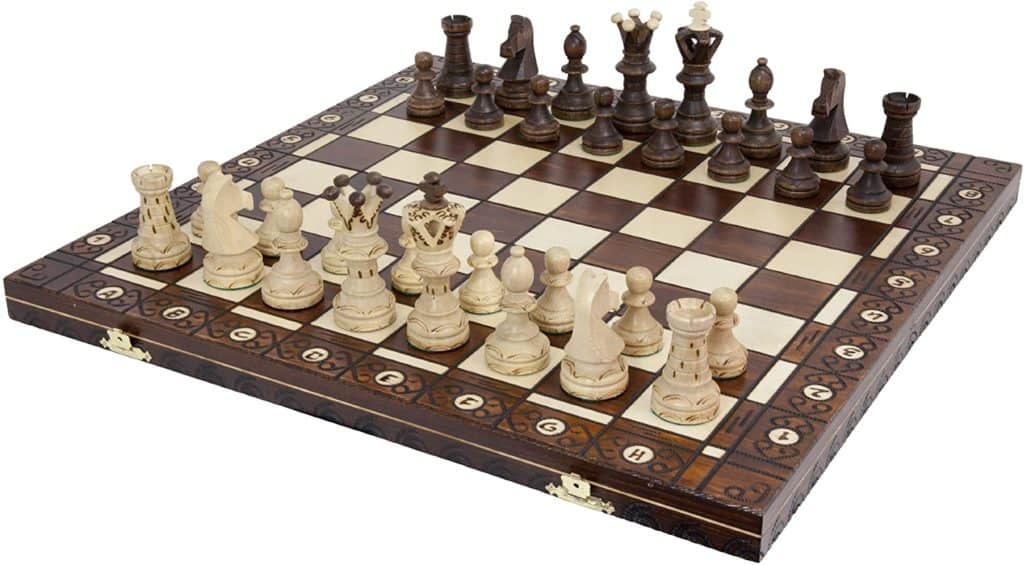
A poem about Fool’s Mate
Unwise for White to push the pawn to three;
Exposing royalty to Black’s attack.
With pawn at Bishop three, one must agree
f3 was not the move to play on Black.
The Black opponent counters with e5
A sure maneuver yielding enterprise.
His queen has open space and hopes to strive
To leave her home and head for White’s demise.
The fool’s deficient understanding, moves
His pawn obliviously (seals his fate)
To square g4. A move I disapprove
Of. Black has won the game, h4! The mate!
The lesson learned from this experience
Don’t play a fool with inexperience.



